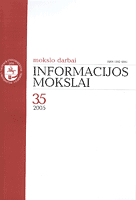Kultūros paveldo institucijų plėtra: politikos, technologiju, inovatyvios praktikos ir mokslinių tyrimų sąveika
Development of the Local Cultural Heritage Institutions: Interactions of Policy, Innovative Practice, Technology, and Research
Author(s): Audronė Glosienė, Jurgita RudžionienėSubject(s): Economy
Published by: Vilniaus Universiteto Leidykla
Summary/Abstract: institutions of all kinds has changed. A shift from the use of information on traditional paper-based carriers to electronic formats has taken place. The implementation of technology has brought about the modernisation of basic work processes and widened the range of services and channels of access. There is closer intra- and inter-domain co-operation both at national and international level. It is no longer always easy to draw clear boundaries between archives, libraries and museums in terms of digital content provision. Memory institutions such as libraries, museums and archives are adjusting themselves to the digital age. Web-based services have been expanded, remote use of online catalogues and the accessibility of digitised heritage have all been improved. The task now is to create and promote new services which reach and motivate more people. New services require new tools, many of them ICT-based – and above all a new attitude. European cultural heritage is a function of the collective memory of the varied cultural traditions, communities and individual citizens across Europe. The increasing importance of local cultural identity, combined with the potential of technology, will be a major catalyst for the take up of the Information Society by ordinary citizens and will provide bridges for social inclusion and across the digital divide. Local institutions such as public libraries, museums and archives are essential contributors to these goals. They have to be mobilised to make best use of existing technologies and to contribute to the creation, use and delivery of local cultural content to meet specific local information and learning needs. They also have an enormous need to adopt and benefit from the goals of the IST research programme. The article aims to disclose the interactions of both political and technological factors as well as innovative practice and research in the field of ICTbased services of the cultural heritage institutions. It is based on the experience of participation in and outputs of the CALIMERA Co-ordination Action that was funded under IST FP6 during the 18 months from December 2003 to May 2005. CALIMERA has set out to ensure that local cultural institutions right across Europe are well placed to benefit from and contribute to the goals of the RTD framework programme 2002–2006 in enabling anywhere, anytime, natural access to IST services for all. To achieve theses goals, CALIMERA has monitored technical developments and solutions already emerging from IST and national research and assessed their potential as widely transferable technologies for use by local institutions and citizens. It has also aimed to co-ordinate and sensitise the stakeholders including professional networks, national and local authorities and solution providers, contributing strongly to increased knowledge and confidence for national strategic bodies in designing and implementing IST strate
Journal: Informacijos mokslai
- Issue Year: 2006
- Issue No: 36
- Page Range: 9-25
- Page Count: 17
- Language: Lithuanian

